Chemometric Classification and Geochemistry of Crude Oils in the Eastern Fukang Sag, Junggar Basin, NW China
Abstract
:1. Introduction
2. Samples and Methods
2.1. Samples
2.2. Experimental Methods
2.3. Computational Methods
3. Results
3.1. Principal Component Analysis (PCA)
3.1.1. Parameters Selection
3.1.2. Principal Component Scores
3.2. Hierarchical Cluster Analysis (HCA)
4. Discussion
4.1. Geochemical Characteristics of Oil Families
4.1.1. Sources of Organic Matter
4.1.2. Depositional Environment
4.1.3. Thermal Maturity
4.2. Potential Source Rocks for the Families
5. Conclusions
Author Contributions
Funding
Conflicts of Interest
References
- Peters, K.E.; Walters, C.C.; Moldowan, J.M. The Biomarker Guide, 2nd ed.; Cambridge University Press: New York, NY, USA, 2005. [Google Scholar]
- Peters, K.E.; Moldowan, J.M. The Biomarker Guide: Interpreting Molecular Fossils in Petroleum and Ancient Sediments; Prentice Hall: Englewood Cliffs, NJ, USA, 1993. [Google Scholar]
- Wang, Y.P.; Zhang, F.; Zou, Y.R.; Zhan, Z.W. Chemometrics reveals oil sources in the Fangzheng Fault Depression, NE China. Org. Geochem. 2016, 102, 1–13. [Google Scholar] [CrossRef]
- Wang, Y.P.; Zhou, Y.R.; Shi, J.T.; Shi, J. The application of chemometrics in oil-oil and oil-source rock correlations: Current situation and future prospect. J. Nat. Gas Geosci. 2018, 29, 452–467. [Google Scholar]
- Eneogwe, C.; Ekundayo, O. Geochemical correlation of crude oils in the NW Niger Delta, Nigeria. J. Petrol. Geol. 2003, 26, 95–103. [Google Scholar] [CrossRef]
- Gürgey, K. Correlation, alteration, and origin of hydrocarbons in the GCA, Bahar, and Gum Adasi fields, western South Caspian Basin: Geochemical and multivariate statistical assessments. Mar. Petrol. Geol. 2003, 20, 1119–1139. [Google Scholar] [CrossRef]
- Zumberge, J.E.; Russell, J.A.; Reid, S.A. Charging of Elk Hills reservoirs as determined by oil geochemistry. AAPG Bull. 2005, 89, 1347–1371. [Google Scholar] [CrossRef] [Green Version]
- He, M.; Moldowan, J.M.; Nemchenko-Rovenskaya, A.; Peters, K.E. Oil families and their inferred source rocks in the Barents Sea and northern Timan-Pechora Basin, Russia. AAPG Bull. 2012, 96, 1121–1146. [Google Scholar] [CrossRef]
- Wang, Y.; Peters, K.E.; Moldowan, J.M.; Bird, K.J.; Magoon, L.B. Cracking, mixing, and geochemical correlation of crude oils, North Slope, Alaska Crude Oils, North Slope, Alaska. AAPG Bull. 2014, 98, 1235–1267. [Google Scholar] [CrossRef]
- Mashhadi, Z.S.; Rabbani, A.R. Organic geochemistry of crude oils and Cretaceous source rocks in the Iranian sector of the Persian Gulf: An oil–oil and oil–source rock correlation study. Int. J. Coal Geol. 2015, 146, 118–144. [Google Scholar] [CrossRef]
- Alizadeh, B.; Alipour, M.; Chehrazi, A.; Mirzaie, S. Chemometric classification and geochemistry of oils in the Iranian sector of the southern Persian Gulf Basin. Org. Geochem. 2017, 111, 67–81. [Google Scholar] [CrossRef]
- Lin, X.H.; Zhan, Z.W.; Zou, Y.R.; Sun, J.N.; Peng, P.A. Geochemically Distinct Oil Families in the Gudong Oilfield, Zhanhua Depression, Bohai Bay Basin, China. ACS Omega 2020, 5, 26738–26747. [Google Scholar] [CrossRef]
- Hao, F.; Zhang, Z.; Zou, H.; Zhang, Y.; Yang, Y. Origin and mechanism of the formation of the low-oil-saturation Moxizhuang field, Junggar Basin, China: Implication for petroleum exploration in basins having complex histories. AAPG Bull. 2011, 95, 983–1008. [Google Scholar] [CrossRef]
- Gong, S.; Zhou, S.; Li, J.; Fu, D.L.; Wang, B.; Li, Y.J. Comparisons of geochemical characteristics of Carboniferous and Permian main source rocks in Junggar Basin. Nat. Gas Geosci. 2013, 24, 1005–1015. [Google Scholar]
- Song, Y.; Wang, X.; Guo, X.; Liu, C.; Li, H.; Liu, D. Analysis on causes of differences in physical properties of Jurassic crude oil around Fukang depression, Junggar Basin. Petrol. Sci. Technol. 2020, 38, 75–82. [Google Scholar] [CrossRef]
- Chen, Z.; Xie, J.; Qiao, R.; Qiu, L.; Yang, Y.; Wen, Z.; Xu, Y.; Tang, Y. Geochemistry and accumulation of Jurassic oil in the central Junggar Basin, western China. J. Petrol. Sci. Eng. 2022, 216, 110855. [Google Scholar] [CrossRef]
- Yang, B.; Yan, Z.M.; You, Q.M.; Han, J.; Guan, Q.; Reng, J.L.; Wang, J.Y. Geochemical characteristics of carboniferous crude oil in Jundong Area. Xinjiang Petrol. Geol. 2002, 23, 478. [Google Scholar]
- Zhao, Y.; Tan, K.; Wang, P.; Guo, X.; Qi, W. Geochemical Characteristics of Carboniferous Source Rocks and Distribution in the Eastern Part of Junggar Basin. Nat. Gas Geosci. 2011, 22, 753–759. [Google Scholar]
- Yang, F.; Song, Y.; Chen, H.; Gong, D.; Bian, B.; Liu, H. Evaluation of Carboniferous Songkaersu Formation source rocks and gas-source correlation in the Fukang Sag of eastern Junggar Basin. Nat. Gas Geosci 2019, 30, 1018–1026. [Google Scholar]
- Yu, S.; Wang, X.; Xiang, B.; Liao, J.; Wang, J.; Li, E.; Yan, Y.; Cai, Y.; Zou, Y.; Pan, C. Organic geochemistry of Carboniferous source rocks and their generated oils from the Eastern Junggar Basin, NW China. Org. Geochem. 2014, 77, 72–88. [Google Scholar] [CrossRef]
- Bai, H.; Pang, X.; Kuang, L.; Wan, Z.; Pang, H.; Wang, X.; Jia, X.; Song, X. Depositional environment, hydrocarbon generation and expulsion potential of the middle Permian Pingdiquan source rocks based on geochemical analyses in the eastern Junggar Basin, NW China. Aust. J. Earth Sci. 2017, 64, 497–518. [Google Scholar] [CrossRef]
- Shi, J.; Zou, Y.; Yu, J.; Liu, J. Paleoenvironment of organic-rich shale from the Lucaogou Formation in the Fukang Sag, Junggar Basin, China. Nat. Gas Geosci. 2018, 29, 1138–1150. [Google Scholar]
- Qiao, J.; Liu, L.; Shang, X. Deposition conditions of the Jurassic lacustrine source rocks in the East Fukang Sag, Junggar Basin, NW China: Evidence from major and trace elements. Geol. J. 2020, 55, 4936–4953. [Google Scholar] [CrossRef]
- Peters, K.E.; Hostettler, F.D.; Lorenson, T.D.; Rosenbauer, R.J. Families of Miocene Monterey crude oil, seep, and tarball samples, coastal California. AAPG Bull. 2008, 92, 1131–1152. [Google Scholar] [CrossRef]
- Jiang, C.X. Origins of the Jurassic oils in the east and peripheral areas of Fukang Depression in the Junggar Basin. Master Dissertation, China University of Petroleum (East China), Qingdao, China, 2016. [Google Scholar]
- Liu, H.; Li, H.; Xiang, H.; Wang, X.; Du, S. Geochemistry, genesis and distribution of crude oils in the Fukang fault zones and their periphery in Junggar Basin. Nat. Gas Geosci. 2020, 31, 258–267. [Google Scholar]
- Jiang, W.; Yiming, A.; Li, H.; Chen, J.; Li, Z. Geochemical characteristics and identification of mixed crude oil of the Baikouquan Formation Lower Wuerhe Formation on the East slope of the Mahu Sag, Junggar Basin. Geochimica 2021, 50, 185–198. [Google Scholar]
- Sofer, Z. Stable carbon isotope compositions of crude oils: Application to source depositional environments and petroleum alteration. AAPG Bull. 1984, 68, 31–49. [Google Scholar]
- Schoell, M. Recent advances in petroleum isotope geochemistry. Org. Geochem. 1984, 6, 645–663. [Google Scholar] [CrossRef]
- Clayton, J.L.; Yang, J.; King, J.D.; Lillis, P.G.; Warden, A. Geochemistry of oils from the Junggar basin, northwest China. AAPG Bull. 1997, 81, 1926–1944. [Google Scholar]
- Chen, J.; Liang, D.; Wang, X.; Zhong, N.; Song, F.; Deng, C.; Shi, X.; Jin, T.; Xiang, S. Mixed oils derived from multiple source rocks in the Cainan oilfield, Junggar Basin, Northwest China. Part I: Genetic potential of source rocks, features of biomarkers and oil sources of typical crude oils. Org. Geochem. 2003, 34, 889–909. [Google Scholar] [CrossRef]
- Chen, J.; Deng, C.; Liang, D.; Wang, X.; Zhong, N.; Song, F.; Shi, X.; Xiang, S. Mixed oils derived from multiple source rocks in the Cainan oilfield, Junggar Basin, Northwest China. Part II: Artificial mixing experiments on typical crude oils and quantitative oil–source correlation. Org. Geochem. 2003, 34, 911–930. [Google Scholar] [CrossRef]
- Peters, K.E.; Scott Ramos, L.; Zumberge, J.E.; Valin, Z.C.; Scotese, C.R.; Gautier, D.L. Circum-Arctic petroleum systems identified using decision-tree chemometrics. AAPG Bull. 2007, 91, 877–913. [Google Scholar] [CrossRef]
- Peters, K.E.; Wright, T.L.; Ramos, L.S.; Zumberge, J.E.; Magoon, L.B. Chemometric recognition of genetically distinct oil families in the Los Angeles basin, California. AAPG Bull. 2016, 100, 115–135. [Google Scholar] [CrossRef]
- Wang, D.H.; Ma, Y.M. Multivariate Statistical Analysis and SPSS Application, 2nd ed.; East China University of Science and Technology Press: Shanghai, China, 2018. [Google Scholar]
- Tzeng, G.H.; Chiang, C.H.; Li, C.W. Evaluating intertwined effects in e-learning programs: A novel hybrid MCDM model based on factor analysis and DEMATEL. Expert Syst. Appl. 2007, 32, 1028–1044. [Google Scholar] [CrossRef]
- Gu, H.; Ma, F.; Guo, J. Hydrochemistry, multidimensional statistics, and rock mechanics investigations for Sanshandao Gold Mine, China. Arab. J. Geosci. 2017, 10, 62. [Google Scholar] [CrossRef]
- Philp, R.P.; Gilbert, T.D. Biomarker distributions in Australian oils predominantly derived from terrigenous source material. Org. Geochem. 1986, 10, 73–84. [Google Scholar] [CrossRef]
- Hanson, A.D.; Zhang, S.C.; Moldowan, J.M.; Liang, D.G.; Zhang, B.M. Molecular organic geochemistry of the Tarim Basin, northwest China. AAPG Bull. 2000, 84, 1109–1128. [Google Scholar]
- Osorno, J.; Rangel, A. Geochemical assessment and petroleum systems in the Sinú-San Jacinto Basin, northwestern Colombia. Mar. Petrol. Geol. 2015, 65, 217–231. [Google Scholar] [CrossRef]
- Moldowan, J.M.; Seifert, W.K.; Gallegos, E.J. Relationship between petroleum composition and depositional environment of petroleum source rocks. AAPG Bull. 1985, 69, 1255–1268. [Google Scholar]
- Didyk, B.M.; Simoneit, B.R.T.; Brassell, S.T.; Eglinton, G. Organic geochemical indicators of palaeoenvironmental conditions of sedimentation. Nature 1978, 272, 216–222. [Google Scholar] [CrossRef]
- Peters, K.E.; Fraser, T.H.; Amris, W.; Rustanto, B.; Hermanto, E. Geochemistry of crude oils from eastern Indonesia. AAPG Bull. 1999, 83, 1927–1942. [Google Scholar]
- Jiang, Z.S.; Fowler, M.G. Carotenoid-derived alkanes in oils from northwestern China. Org. Geochem. 1986, 10, 831–839. [Google Scholar] [CrossRef]
- Holba, A.G.; Ellis, L.; Dzou, I.L.; Hallam, A.; Masterson, W.D.; Francu, J.; Fincannon, A.L. Extended tricyclic terpanes as age discriminators between Triassic, Early Jurassic and Middle−Late Jurassic oils. In Proceedings of the 20th International Meeting on Organic Geochemistry, Nancy, France, 10–14 September 2001. [Google Scholar]
- Waples, D.W.; Machihara, T. Application of Sterane and Triterpane Biomarkers in Petroleum Exploration. Bull. Can. Petrol. Geol. 1990, 38, 357–380. [Google Scholar]
- Justwan, H.; Dahl, B.; Isaksen, G.H. Geochemical Characterization and Genetic Origin of Oils and Condensates in the South Viking Graben, Norway. Mar. Petrol. Geol. 2006, 23, 213–239. [Google Scholar] [CrossRef]
- Mackenzie, A.S.; Patience, R.L.; Maxwell, J.R.; Vandenbroucke, M.; Durand, B. Molecular parameters of maturation in the Toarcian shales, Paris Basin, France—I. Changes in the configurations of acyclic isoprenoid alkanes, steranes and triterpanes. Geochim. Cosmochim. Acta 1980, 44, 1709–1721. [Google Scholar] [CrossRef]
- Katz, B.; Richards, D.; Long, D.; Lawrence, W. A new look at the components of the petroleum system of the South Caspian Basin. J. Petrol. Sci. Eng. 2000, 28, 161–182. [Google Scholar] [CrossRef]
- Philp, R.P.; Fan, Z. Geochemical investigation of oils and source rocks from Qianjiang Depression of Jianghan Basin, a terrigenous saline basin, China. Org. Geochem. 1987, 11, 549–562. [Google Scholar] [CrossRef]
- Wang, L.; Chen, S.; Zhang, H.; Zou, X.; Zhan, P.; Lu, J. Geochemical characteristic and origin of solid bitumen in the Jurassic and Triassic sandstone reservoir of Santai Area, Junggar Basin, NW China. Petrol. Sci. Technol. 2016, 34, 539–545. [Google Scholar] [CrossRef]
- Qu, Y.; Tao, H.; Ma, D.; Wu, T.; Qiu, J. Biomarker characteristics and geological significance of middle and upper Permian source rocks in the southeastern Junggar Basin. Petrol. Sci. Technol. 2019, 37, 2066–2080. [Google Scholar] [CrossRef]
- Chen, J.Q.; Pang, X.Q.; Pang, H. Lateral migration of Jurassic Toutunhe Formation in Fudong slope, Junggar Basin. Earth Sci. 2016, 41, 821–831. [Google Scholar]

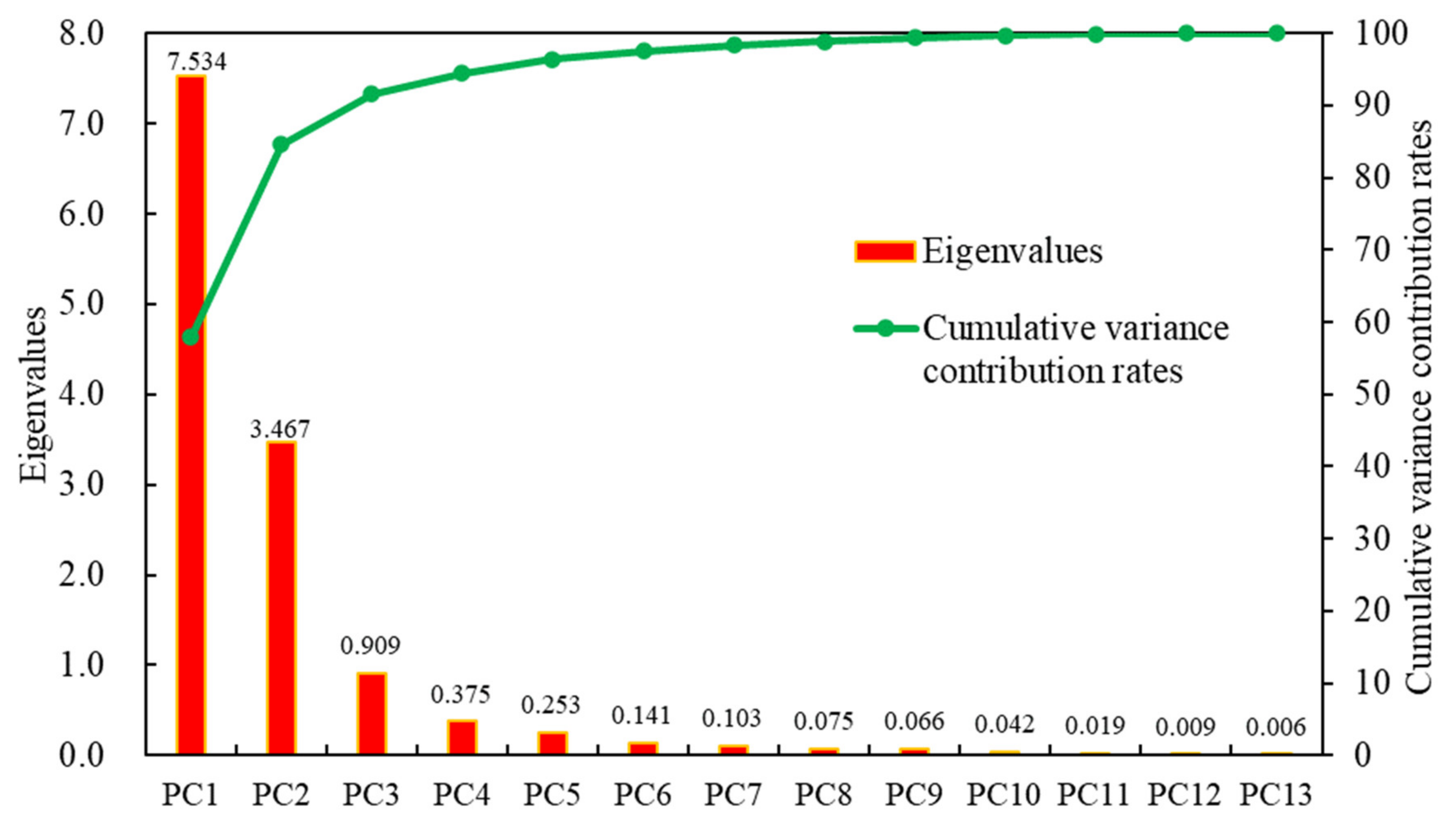
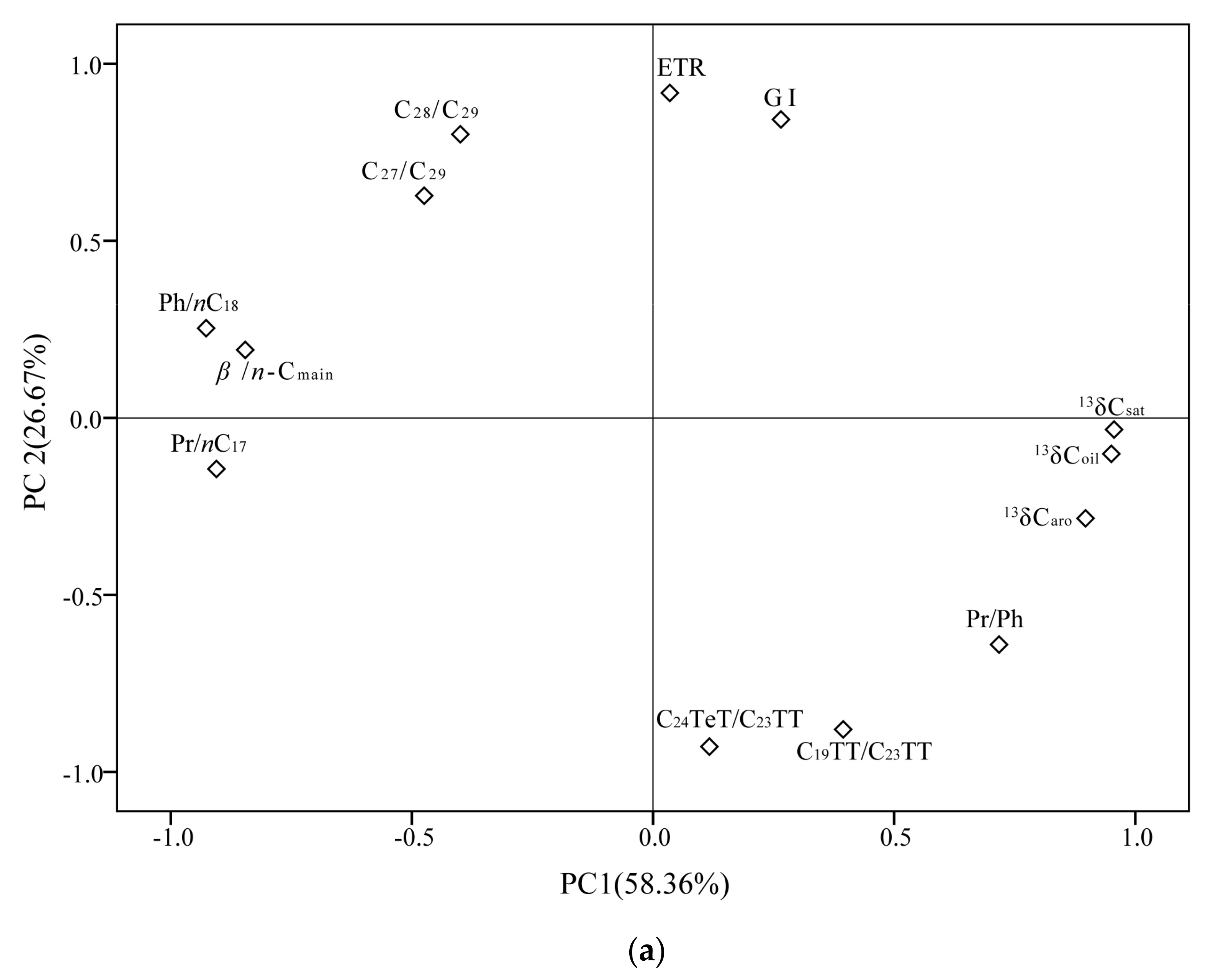
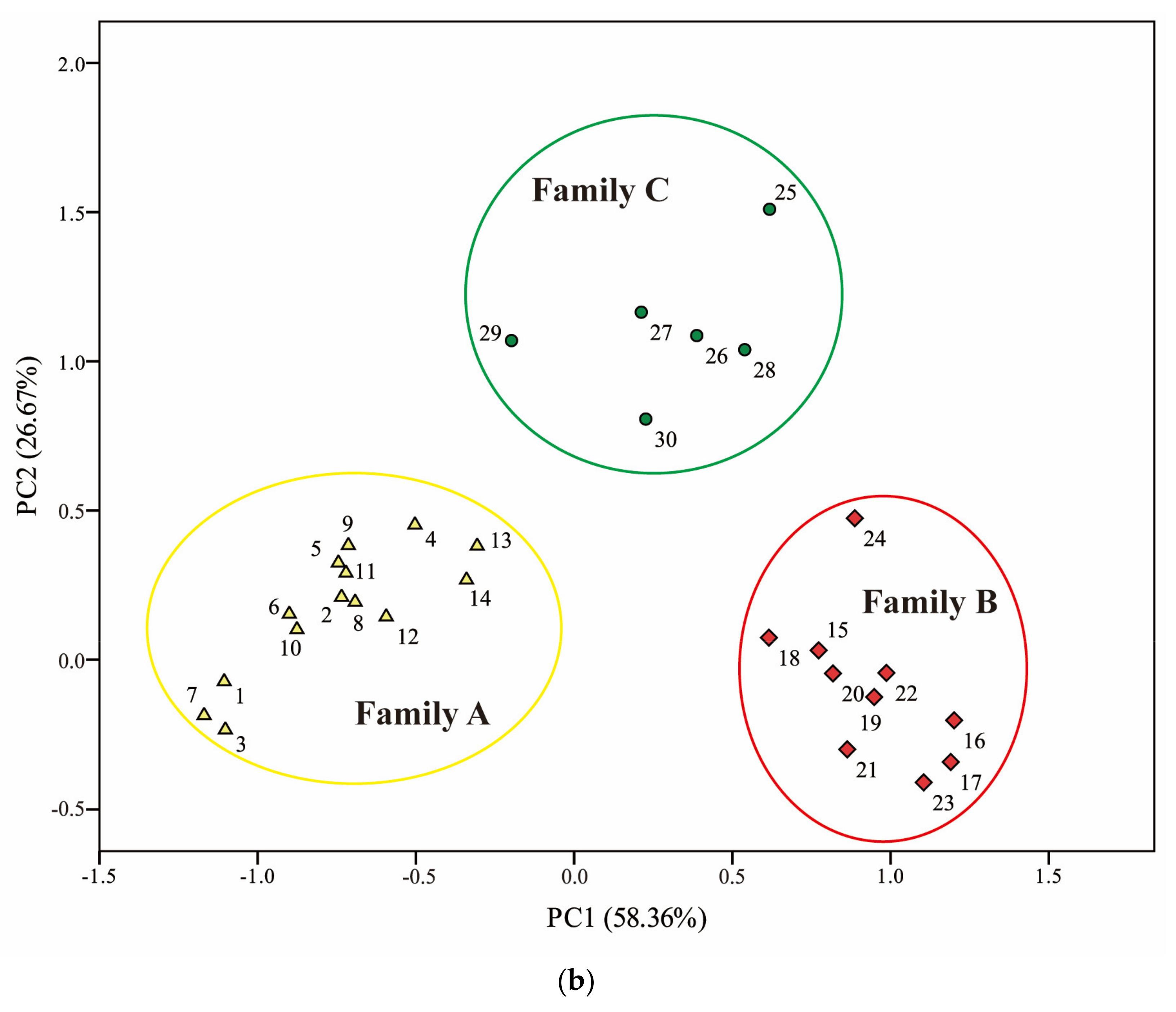
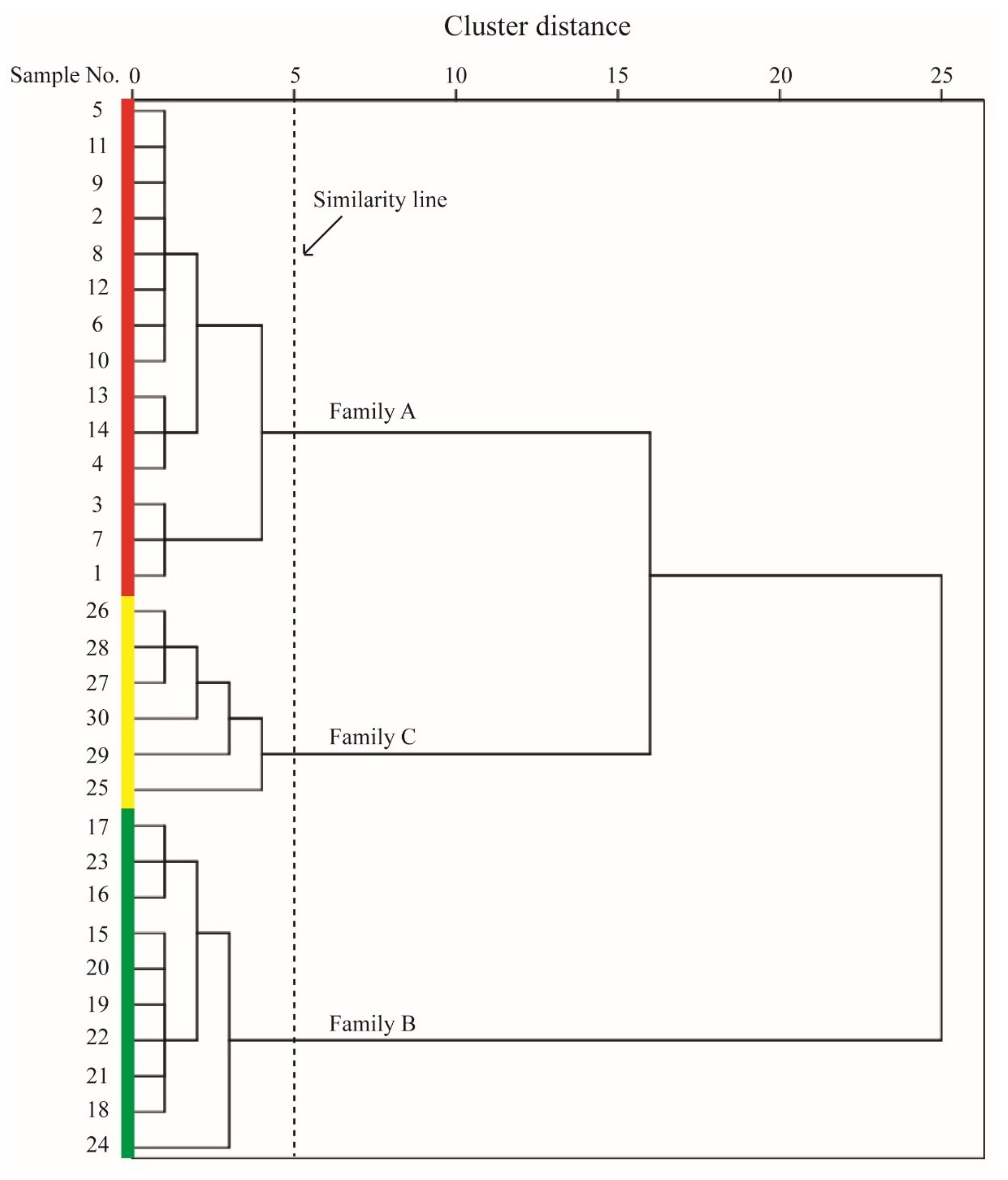
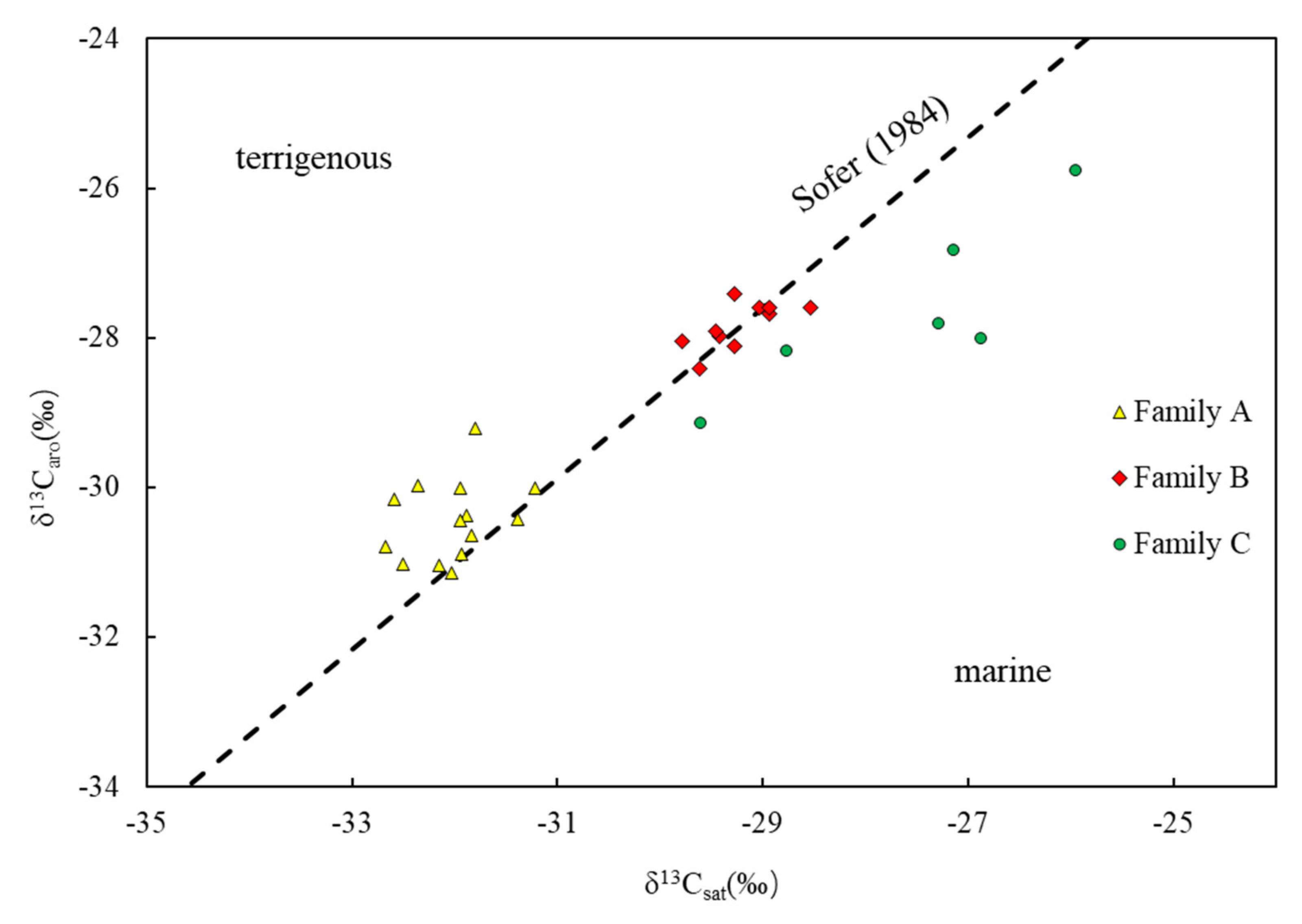
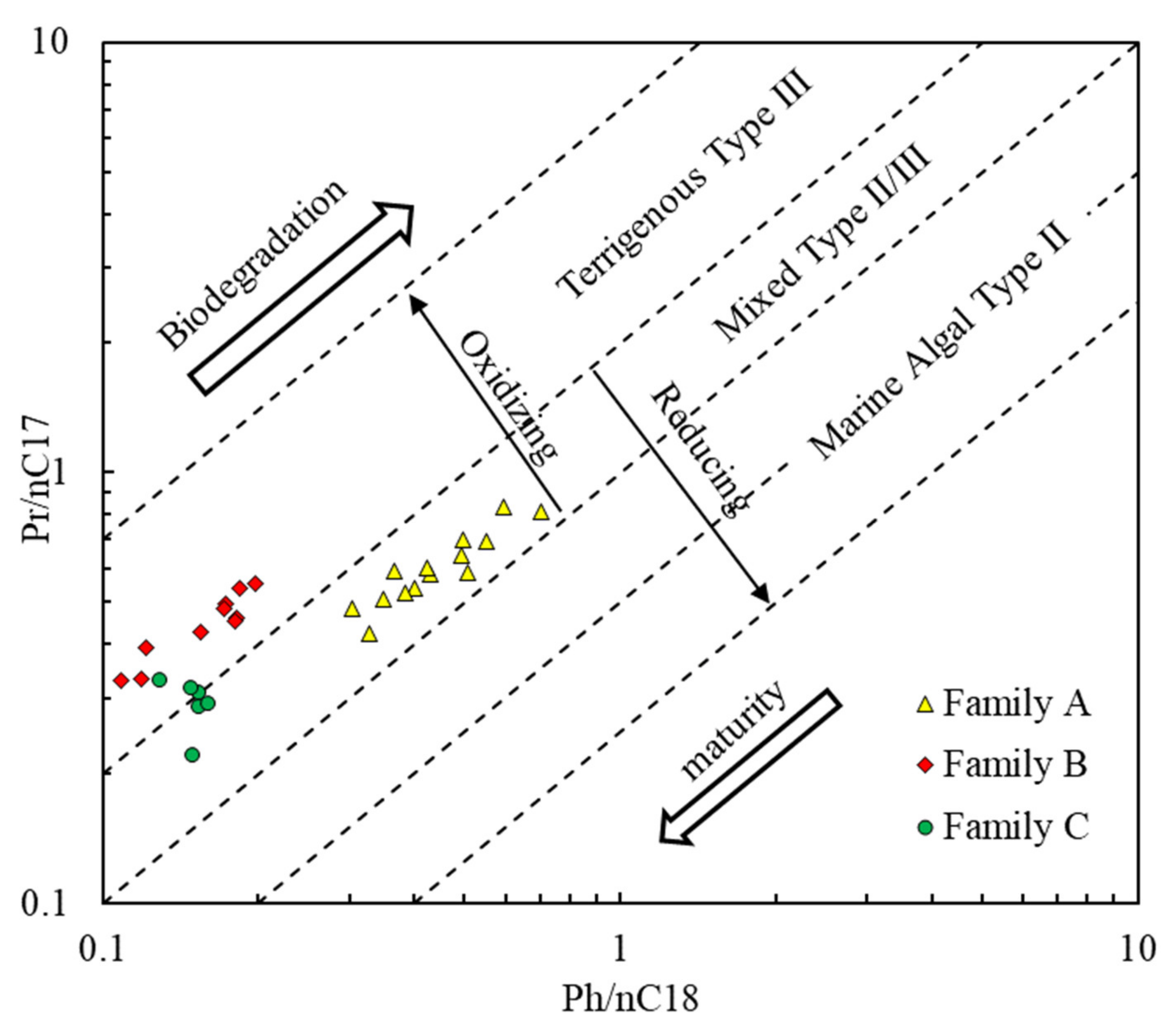




| Sample No. | Well | Fm. | Depth (m) | δ13Coil (‰) | δ13Csat (‰) | δ13Caro (‰) | Pr/Ph | Pr/nC17 | Ph/nC18 | β/n-Cmain | C19TT/C23TT | C24Te/C23TT | GI | ETR | C27/C29 | C28/C29 | Oil Family |
|---|---|---|---|---|---|---|---|---|---|---|---|---|---|---|---|---|---|
| 1 | F46 | P2l | 3157~3165 | −32.23 | −32.15 | −31.05 | 1.48 | 0.70 | 0.50 | 0.67 | 0.12 | 0.36 | 0.16 | 0.54 | 0.53 | 0.63 | A |
| 2 | SQ12 | P3wt | 2902~2926 | −31.73 | −32.59 | −30.16 | 1.55 | 0.59 | 0.37 | 0.30 | 0.19 | 0.29 | 0.14 | 0.61 | 0.42 | 0.67 | |
| 3 | B307 | P3wt | 2266~2270 | −31.65 | −32.36 | −29.98 | 1.31 | 0.83 | 0.60 | 0.69 | 0.19 | 0.43 | 0.15 | 0.51 | 0.51 | 0.66 | |
| 4 | XQ5 | T2k | 2382~2392 | −30.97 | −31.39 | −30.42 | 1.40 | 0.42 | 0.33 | 0.18 | 0.16 | 0.45 | 0.16 | 0.68 | 0.30 | 0.74 | |
| 5 | F19 | T2k | 2368~2371 | −31.49 | −31.89 | −30.37 | 1.41 | 0.54 | 0.40 | 0.31 | 0.20 | 0.39 | 0.18 | 0.63 | 0.33 | 0.85 | |
| 6 | T31 | J2t | 2301.5~2348.6 | −31.87 | −32.03 | −31.15 | 1.22 | 0.58 | 0.51 | 0.30 | 0.13 | 0.47 | 0.16 | 0.62 | 0.41 | 0.71 | |
| 7 | T62 | T2k | 2790~2795 | −31.86 | −32.68 | −30.8 | 1.20 | 0.81 | 0.71 | 0.55 | 0.16 | 0.45 | 0.14 | 0.60 | 0.39 | 0.69 | |
| 8 | F006 | P3wt | 2770~2780 | −31.09 | −31.93 | −30.89 | 1.28 | 0.64 | 0.49 | 0.14 | 0.18 | 0.39 | 0.15 | 0.63 | 0.24 | 0.77 | |
| 9 | F25 | P3wt | 2775~2783 | −31.45 | −31.84 | −30.64 | 1.41 | 0.52 | 0.38 | 0.22 | 0.19 | 0.40 | 0.16 | 0.68 | 0.34 | 0.81 | |
| 10 | B403 | C2b | 2756.5~2769 | −31.33 | −31.95 | −30.45 | 1.35 | 0.69 | 0.55 | 0.38 | 0.12 | 0.41 | 0.16 | 0.62 | 0.32 | 0.75 | |
| 11 | B418 | J2t | 1873~1907 | −31.51 | −32.51 | −31.03 | 1.35 | 0.58 | 0.43 | 0.11 | 0.18 | 0.42 | 0.18 | 0.67 | 0.28 | 0.79 | |
| 12 | B418 | E | 1773~1779 | −31.32 | −31.95 | −30.01 | 1.38 | 0.60 | 0.42 | 0.17 | 0.15 | 0.44 | 0.14 | 0.58 | 0.39 | 0.62 | |
| 13 | F010 | P3w | 2756~2779 | −30.66 | −31.22 | −30.01 | 1.69 | 0.48 | 0.30 | 0.19 | 0.17 | 0.31 | 0.17 | 0.64 | 0.25 | 0.55 | |
| 14 | F43 | P3w | 3132~3214 | −31.56 | −31.8 | −29.21 | 1.51 | 0.51 | 0.35 | 0.15 | 0.18 | 0.33 | 0.12 | 0.64 | 0.23 | 0.56 | |
| 15 | XQ12 | J2t | 2359~2371 | −28.49 | −29.28 | −28.11 | 2.72 | 0.46 | 0.18 | 0.07 | 0.51 | 0.64 | 0.08 | 0.52 | 0.20 | 0.30 | B |
| 16 | FD021 | J2x | 3620~3625 | −28.46 | −28.94 | −27.68 | 3.17 | 0.39 | 0.12 | 0.03 | 0.86 | 0.92 | 0.07 | 0.47 | 0.20 | 0.30 | |
| 17 | F32 | J2t | 3277~3286 | −28.43 | −29.03 | −27.6 | 2.75 | 0.43 | 0.16 | 0.01 | 0.93 | 0.94 | 0.05 | 0.42 | 0.17 | 0.28 | |
| 18 | FD9 | J2t | 2813~2879 | −29.09 | −29.62 | −28.42 | 2.52 | 0.45 | 0.18 | 0.04 | 0.51 | 0.61 | 0.09 | 0.52 | 0.21 | 0.42 | |
| 19 | FD052 | J2t | 3038~3047 | −29.05 | −29.28 | −27.42 | 2.86 | 0.50 | 0.17 | 0.04 | 0.86 | 0.72 | 0.09 | 0.50 | 0.17 | 0.38 | |
| 20 | FD052 | J2t | 2963~2974 | −28.65 | −29.42 | −27.98 | 2.78 | 0.48 | 0.17 | 0.05 | 0.69 | 0.66 | 0.08 | 0.49 | 0.21 | 0.38 | |
| 21 | B97 | J1s | 3583~3595 | −29.14 | −29.78 | −28.04 | 2.81 | 0.55 | 0.20 | 0.04 | 0.76 | 0.73 | 0.06 | 0.44 | 0.19 | 0.32 | |
| 22 | FD051 | J2t | 2940~2958 | −28.57 | −29.46 | −27.91 | 2.87 | 0.33 | 0.12 | 0.05 | 0.67 | 0.73 | 0.08 | 0.45 | 0.18 | 0.38 | |
| 23 | FD16 | J1s | 2350~2354 | −28.17 | −28.93 | −27.6 | 2.70 | 0.54 | 0.18 | 0.05 | 1.03 | 1.00 | 0.05 | 0.44 | 0.23 | 0.32 | |
| 24 | FD2 | J2t | 3191~3229 | −28.25 | −28.54 | −27.59 | 3.17 | 0.33 | 0.11 | 0.00 | 0.46 | 0.46 | 0.10 | 0.63 | 0.19 | 0.35 | |
| 25 | KT1 | P2l | 5296~5315 | −25.72 | −25.95 | −25.77 | 2.59 | 0.33 | 0.13 | 0.05 | 0.29 | 0.22 | 0.45 | 0.70 | 0.37 | 0.52 | C |
| 26 | XQ2 | C2b | 2527~2552 | −26.56 | −26.87 | −28.02 | 2.02 | 0.28 | 0.15 | 0 | 0.20 | 0.43 | 0.21 | 0.68 | 0.31 | 0.71 | |
| 27 | XQ114 | C2b | 2490~2513 | −27.2 | −27.28 | −27.82 | 1.98 | 0.29 | 0.16 | 0.02 | 0.18 | 0.32 | 0.19 | 0.71 | 0.32 | 0.81 | |
| 28 | XQ10 | T1j | 2042~2044 | −27.09 | −27.14 | −26.84 | 2.12 | 0.31 | 0.15 | 0.02 | 0.23 | 0.21 | 0.26 | 0.62 | 0.28 | 0.44 | |
| 29 | F19 | T1j | 2673~2680 | −29.39 | −29.6 | −29.14 | 1.61 | 0.22 | 0.15 | 0.02 | 0.25 | 0.33 | 0.20 | 0.73 | 0.44 | 0.86 | |
| 30 | F30 | C | 3218~3248 | −28.55 | −28.77 | −28.18 | 2.23 | 0.32 | 0.15 | 0.03 | 0.25 | 0.38 | 0.22 | 0.57 | 0.33 | 0.77 |
| Variables | δ13Coil | δ13Csat | δ13Caro | Pr/Ph | Pr/nC17 | Ph/nC18 | C27/C29 | C28/C29 | C19TT/C23TT | C24TeT/C23TT | GI | ETR | β/n-Cmain |
|---|---|---|---|---|---|---|---|---|---|---|---|---|---|
| δ13Coil | 1 | ||||||||||||
| δ13Csat | 0.990 | 1 | |||||||||||
| δ13Caro | 0.933 | 0.922 | 1 | ||||||||||
| Pr/Ph | 0.754 | 0.718 | 0.854 | 1 | |||||||||
| Pr/nC17 | −0.769 | −0.796 | −0.675 | −0.528 | 1 | ||||||||
| Ph/nC18 | −0.853 | −0.849 | −0.859 | −0.827 | 0.885 | 1 | |||||||
| C27/C29 | −0.436 | −0.375 | −0.501 | −0.689 | 0.369 | 0.580 | 1 | ||||||
| C28/C29 | −0.474 | −0.427 | −0.658 | −0.843 | 0.170 | 0.539 | 0.652 | 1 | |||||
| C19TT/C23TT | 0.470 | 0.414 | 0.618 | 0.840 | −0.215 | −0.587 | −0.681 | −0.821 | 1 | ||||
| C24TeT/C23TT | 0.229 | 0.164 | 0.333 | 0.643 | −0.002 | −0.336 | −0.590 | −0.695 | 0.913 | 1 | |||
| GI | 0.221 | 0.274 | 0.088 | −0.317 | −0.235 | 0.035 | 0.487 | 0.483 | −0.591 | −0.743 | 1 | ||
| ETR | −0.111 | −0.052 | −0.299 | −0.579 | −0.206 | 0.195 | 0.409 | 0.751 | −0.793 | −0.832 | 0.687 | 1 | |
| β/n-Cmain | −0.735 | −0.710 | −0.693 | −0.653 | 0.820 | 0.865 | 0.723 | 0.395 | −0.491 | −0.298 | 0.046 | 0.039 | 1 |
| Sample No. | Well | Fm. | Depth (m) | C2920S/(20S + 20R) | C29αββ/(ααα + αββ) | C3122S/(22S + 22R) | Ts/Tm | M/H | Oil Family |
|---|---|---|---|---|---|---|---|---|---|
| 1 | F46 | P2l | 3157~3165 | 0.41 | 0.33 | 0.57 | 0.59 | 0.16 | A |
| 2 | SQ12 | P3wt | 2902~2926 | 0.47 | 0.47 | 0.57 | 0.46 | 0.13 | |
| 3 | B307 | P3wt | 2266~2270 | 0.41 | 0.46 | 0.59 | 0.38 | 0.14 | |
| 4 | XQ5 | T2k | 2382~2392 | 0.44 | 0.44 | 0.58 | 0.22 | 0.18 | |
| 5 | F19 | T2k | 2368~2371 | 0.47 | 0.49 | 0.57 | 0.29 | 0.18 | |
| 6 | T31 | J2t | 2301.5~2348.6 | 0.43 | 0.42 | 0.58 | 0.23 | 0.16 | |
| 7 | T62 | T2k | 2790~2795 | 0.42 | 0.41 | 0.61 | 0.30 | 0.17 | |
| 8 | F006 | P3wt | 2770~2780 | 0.45 | 0.45 | 0.57 | 0.27 | 0.17 | |
| 9 | F25 | P3wt | 2775~2783 | 0.45 | 0.47 | 0.58 | 0.25 | 0.16 | |
| 10 | B403 | C2b | 2756.5~2769 | 0.42 | 0.44 | 0.57 | 0.22 | 0.17 | |
| 11 | B418 | J2t | 1873~1907 | 0.42 | 0.42 | 0.55 | 0.21 | 0.19 | |
| 12 | B418 | E | 1773~1779 | 0.43 | 0.46 | 0.57 | 0.46 | 0.15 | |
| 13 | F010 | P3w | 2756~2779 | 0.47 | 0.52 | 0.53 | 0.59 | 0.14 | |
| 14 | F43 | P3w | 3132~3214 | 0.46 | 0.48 | 0.58 | 0.53 | 0.12 | |
| 15 | XQ12 | J2t | 2359~2371 | 0.45 | 0.49 | 0.57 | 0.51 | 0.17 | B |
| 16 | FD021 | J2x | 3620~3625 | 0.41 | 0.46 | 0.57 | 0.35 | 0.21 | |
| 17 | F32 | J2t | 3277~3286 | 0.43 | 0.47 | 0.58 | 0.38 | 0.22 | |
| 18 | FD9 | J2t | 2813~2879 | 0.46 | 0.50 | 0.58 | 0.45 | 0.17 | |
| 19 | FD052 | J2t | 3038~3047 | 0.44 | 0.48 | 0.57 | 0.44 | 0.18 | |
| 20 | FD052 | J2t | 2963~2974 | 0.46 | 0.49 | 0.57 | 0.47 | 0.18 | |
| 21 | B97 | J1s | 3583~3595 | 0.44 | 0.53 | 0.58 | 0.46 | 0.17 | |
| 22 | FD051 | J2t | 2940~2958 | 0.45 | 0.48 | 0.58 | 0.46 | 0.18 | |
| 23 | FD16 | J1s | 2350~2354 | 0.45 | 0.50 | 0.58 | 0.54 | 0.17 | |
| 24 | FD2 | J2t | 3191~3229 | 0.45 | 0.50 | 0.56 | 0.61 | 0.18 | |
| 25 | KT1 | P2l | 5296~5315 | 0.44 | 0.59 | 0.41 | 2.07 | 0.17 | C |
| 26 | XQ2 | C2b | 2527~2552 | 0.46 | 0.48 | 0.63 | 0.26 | 0.28 | |
| 27 | XQ114 | C2b | 2490~2513 | 0.47 | 0.46 | 0.56 | 0.28 | 0.18 | |
| 28 | XQ10 | T1j | 2042~2044 | 0.48 | 0.57 | 0.44 | 2.87 | 0.14 | |
| 29 | F19 | T1j | 2673~2680 | 0.47 | 0.45 | 0.60 | 0.33 | 0.17 | |
| 30 | F30 | C | 3218~3248 | 0.44 | 0.50 | 0.60 | 0.74 | 0.16 |
| Parameters | Carboniferous | Permian | Jurassic |
|---|---|---|---|
| δ13C | >−26‰ | <−30‰ | >−28‰ |
| Pr/Ph | >2 | 1~2 | >2.5 |
| C27-C28-C29 regular steranes | “ascending” or “reverse L”-shaped, C29 >> C28 >> C27 | “ascending” type, abundance in C28 and C29 | “ascending” or “reverse L”-shaped, C29 >> C28 >> C27 |
| C19-C21-C23 TT | “descending” type | “ascending” or “mountain peak” type | “descending” type |
| Gammacerane/C30Hopane | >0.2 | >0.1 | <0.1 |
| β-carotane | not detected | abundant | not detected |
Publisher’s Note: MDPI stays neutral with regard to jurisdictional claims in published maps and institutional affiliations. |
© 2022 by the authors. Licensee MDPI, Basel, Switzerland. This article is an open access article distributed under the terms and conditions of the Creative Commons Attribution (CC BY) license (https://creativecommons.org/licenses/by/4.0/).
Share and Cite
Li, E.; Li, Y.; Xiang, B.; Hou, D.; Mi, J.; Han, X.; Zhang, Y.; Gao, X. Chemometric Classification and Geochemistry of Crude Oils in the Eastern Fukang Sag, Junggar Basin, NW China. Energies 2022, 15, 8921. https://doi.org/10.3390/en15238921
Li E, Li Y, Xiang B, Hou D, Mi J, Han X, Zhang Y, Gao X. Chemometric Classification and Geochemistry of Crude Oils in the Eastern Fukang Sag, Junggar Basin, NW China. Energies. 2022; 15(23):8921. https://doi.org/10.3390/en15238921
Chicago/Turabian StyleLi, Erting, Yan Li, Baoli Xiang, Dujie Hou, Julei Mi, Xu Han, Yu Zhang, and Xiuwei Gao. 2022. "Chemometric Classification and Geochemistry of Crude Oils in the Eastern Fukang Sag, Junggar Basin, NW China" Energies 15, no. 23: 8921. https://doi.org/10.3390/en15238921




